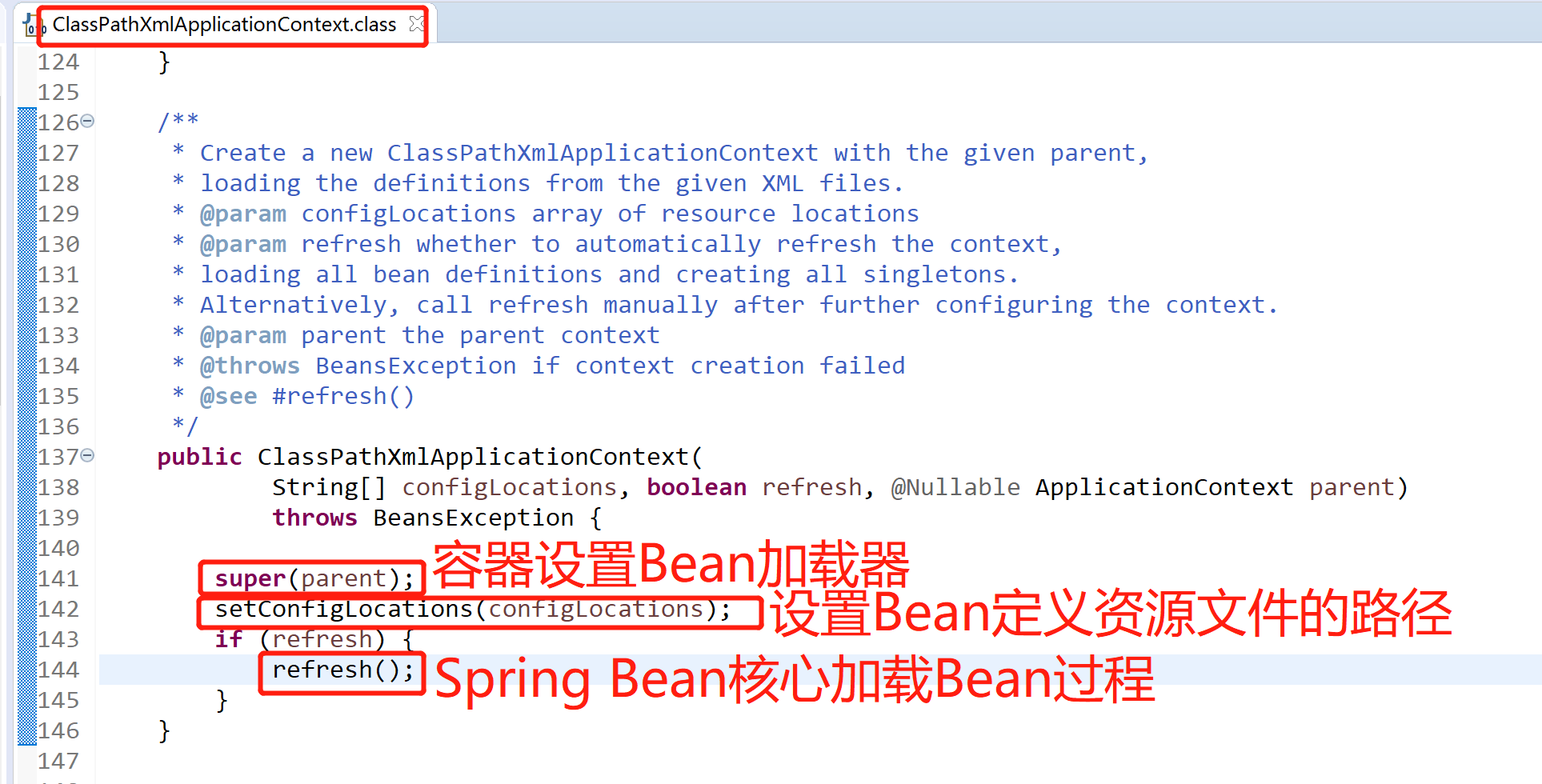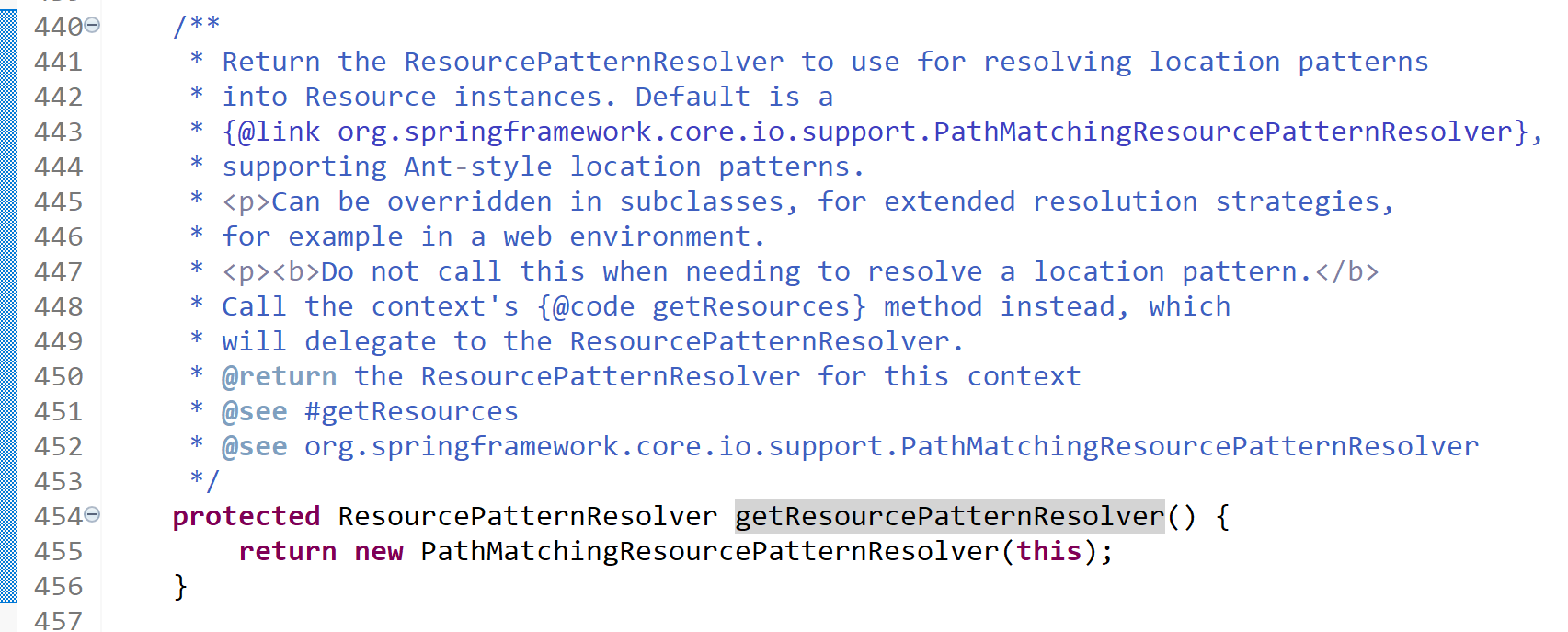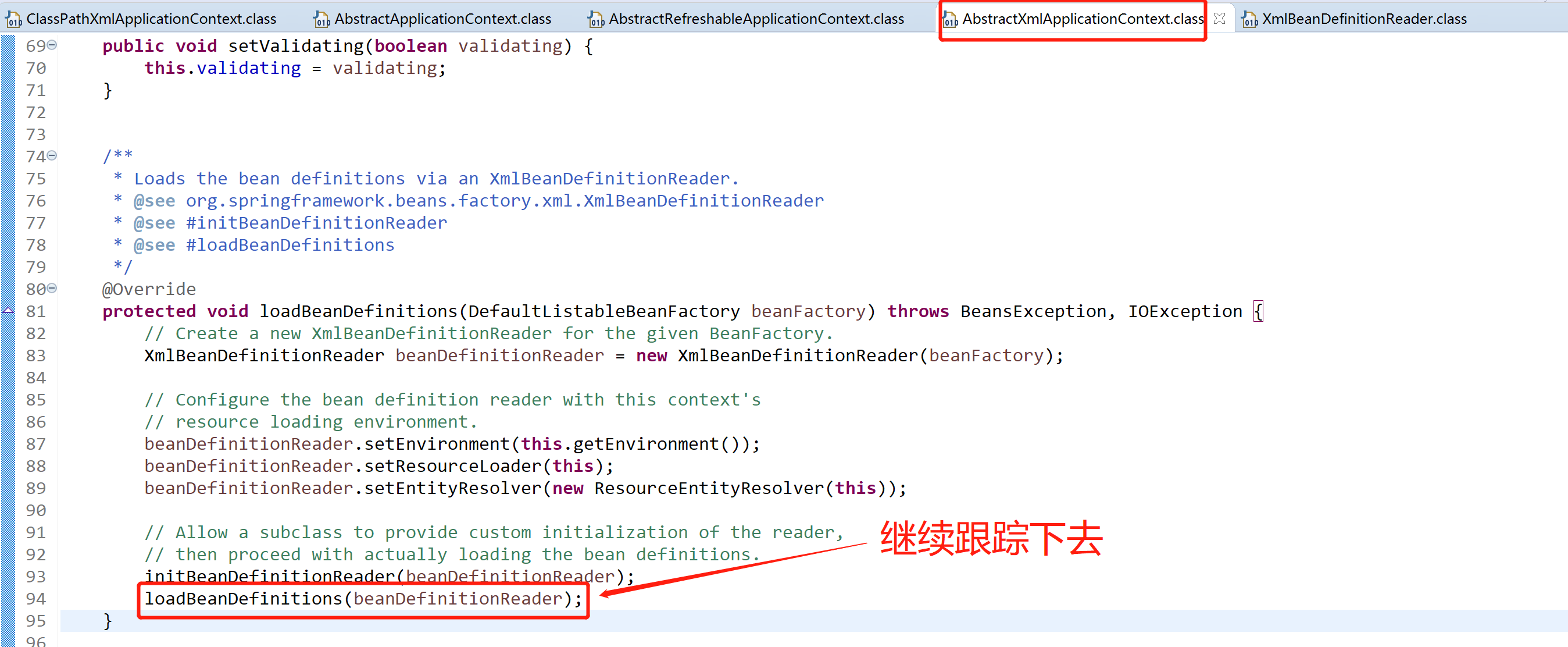本文主要讲解Spring加载xml配置文件的方式,跟踪加载BeanDefinition的全过程。
源码分析
源码的入口

ClassPathXmlApplicationContext构造函数
new ClassPathXmlApplicationContext(“spring.xml”)用于加载CLASSPATH下的Spring配置文件,将配置文件传给构造函数,然后调用类内部的另外一个重载方法。


从构造函数中,可以看到一共做了3件事
super(parent)
super(parent)的作用是为容器设置Bean资源加载器,层层跟踪,可知实际是由其父类AbstractApplicationContext完成设置的,parent为null,setParent(parent)就不继续跟踪了,这里需要注意的是,该类继承了DefaultResourceLoader,所以该类也作为资源加载器
AbstractApplicationContext.java

跟踪该类this()无参构造函数进去看看
AbstractApplicationContext.java

AbstractApplicationContext.java

PathMatchingResourcePatternResolver.java

setConfigLocations(configLocations)
设置Bean定义资源的路径,由其父类AbstractRefreshableConfigApplicationContext完成,resolvePath解析路径,一直跟踪到底层是调用PropertyPlaceholderHelper的parseStringValue完成设置的

refresh()
这个就是整个Spring Bean加载的核心里面十二大步,用于刷新整个Spring上下文信息,定义了整个Spring上下文加载的流程。
@Override public void refresh() throws BeansException, IllegalStateException { synchronized (this.startupShutdownMonitor) { //1、 Prepare this context for refreshing. prepareRefresh(); //创建DefaultListableBeanFactory(真正生产和管理bean的容器) //加载BeanDefition并注册到BeanDefitionRegistry //通过NamespaceHandler解析自定义标签的功能(比如:context标签、aop标签、tx标签) //2、 Tell the subclass to refresh the internal bean factory. ConfigurableListableBeanFactory beanFactory = obtainFreshBeanFactory(); //3、 Prepare the bean factory for use in this context. prepareBeanFactory(beanFactory); try { //4、 Allows post-processing of the bean factory in context subclasses. postProcessBeanFactory(beanFactory); //实例化并调用实现了BeanFactoryPostProcessor接口的Bean //比如:PropertyPlaceHolderConfigurer(context:property-placeholer) //就是此处被调用的,作用是替换掉BeanDefinition中的占位符(${})中的内容 //5、 Invoke factory processors registered as beans in the context. invokeBeanFactoryPostProcessors(beanFactory); //创建并注册BeanPostProcessor到BeanFactory中(Bean的后置处理器) //比如:AutowiredAnnotationBeanPostProcessor(实现@Autowired注解功能) // RequiredAnnotationBeanPostProcessor(实现@d注解功能) //这些注册的BeanPostProcessor //6、 Register bean processors that intercept bean creation. registerBeanPostProcessors(beanFactory); //7、 Initialize message source for this context. initMessageSource(); //8、 Initialize event multicaster for this context. initApplicationEventMulticaster(); //9、 Initialize other special beans in specific context subclasses. onRefresh(); //10、 Check for listener beans and register them. registerListeners(); //创建非懒加载方式的单例Bean实例(未设置属性) //填充属性 //初始化实例(比如调用init-method方法) //调用BeanPostProcessor(后置处理器)对实例bean进行后置处理 //11、 Instantiate all remaining (non-lazy-init) singletons. finishBeanFactoryInitialization(beanFactory); //12、 Last step: publish corresponding event. finishRefresh(); } catch (BeansException ex) { if (logger.isWarnEnabled()) { logger.warn("Exception encountered during context initialization - " + "cancelling refresh attempt: " + ex); } // Destroy already created singletons to avoid dangling resources. destroyBeans(); // Reset 'active' flag. cancelRefresh(ex); // Propagate exception to caller. throw ex; } finally { // Reset common introspection caches in Spring's core, since we // might not ever need metadata for singleton beans anymore... resetCommonCaches(); } } }
总结:
- 方法加了个类锁,避免了多线程同时刷新Spring上下文。
- 锁的这个对象为this.startupShutdownMonitor,有两个好处
- refresh()方法和close()方法都使用了this.startupShutdownMonitor,保证了在调用refresh()方法的时候无法使用close()方法,反之亦然,避免了冲突
- 使用对象锁可以减少同步的范围,只对不能并发的代码块进行加锁,提高了整体代码的运行效率。
- refresh()函数是一个模板方法,执行多个方法,而且提供了各个protected方法(默认实现),其子类可以重写他们。
- 模板方法模式:在一个方法中定义一个算法的骨架,而将一些步骤延迟到子类中。模板方法使得子类(protected方法)可以在不改变算法结构的情况下,重新定义算法中的某些步骤。
refresh()核心调用obtainFreshBeanFactory()
obtainFreshBeanFactory()函数调用,完成了容器初始化的最基础的功能,Bean定义资源的Resource定位、加载解析和注册
AbstractApplicationContext.java
protected ConfigurableListableBeanFactory obtainFreshBeanFactory() { //使用的委派模式,调用2个抽象方法,定义了obtainFreshBeanFactory的算法骨架,实际的行为交给了子类AbstractRefreshableApplicationContext实现 refreshBeanFactory(); ConfigurableListableBeanFactory beanFactory = getBeanFactory(); if (logger.isDebugEnabled()) { logger.debug("Bean factory for " + getDisplayName() + ": " + beanFactory); } return beanFactory; }
AbstractRefreshableApplicationContext.java
/** * This implementation performs an actual refresh of this context's underlying * bean factory, shutting down the previous bean factory (if any) and * initializing a fresh bean factory for the next phase of the context's lifecycle. */ @Override protected final void refreshBeanFactory() throws BeansException { //若有容器,销毁容器中的bean,关闭容器,以此保证refresh()之后使用的是新建立起来的IoC容器 if (hasBeanFactory()) { destroyBeans(); closeBeanFactory(); } try { //创建IoC容器 DefaultListableBeanFactory beanFactory = createBeanFactory(); beanFactory.setSerializationId(getId()); customizeBeanFactory(beanFactory); //调用加载bean定义的方法,使用了委派模式,在当前类中定义了抽象的loadBeanDefinitions方法,具体实现交给子类 loadBeanDefinitions(beanFactory); synchronized (this.beanFactoryMonitor) { this.beanFactory = beanFactory; } } catch (IOException ex) { throw new ApplicationContextException("I/O error parsing bean definition source for " + getDisplayName(), ex); } }st
在这个方法中,先判断BeanFactory是否存在,若存在,则先销毁并关闭BeanFactory接着创建DefaultListableBeanFactory,并调用loadBeanDefinitions装在bean使用了委派模式,在当前类中只定义了抽象的loadBeanDefinitions方法,具体的实现交给子类AbstractXmlApplicationContext
AbstractXmlApplicationContext.java
/** * Loads the bean definitions via an XmlBeanDefinitionReader. * @see org.springframework.beans.factory.xml.XmlBeanDefinitionReader * @see #initBeanDefinitionReader * @see #loadBeanDefinitions */ @Override protected void loadBeanDefinitions(DefaultListableBeanFactory beanFactory) throws BeansException, IOException { // 为给定的bean工厂创建一个新的xmlbeanfinitionReader XmlBeanDefinitionReader beanDefinitionReader = new XmlBeanDefinitionReader(beanFactory); //使用此上下文的bean定义读取器配置 // 资源加载环境 beanDefinitionReader.setEnvironment(this.getEnvironment()); beanDefinitionReader.setResourceLoader(this); beanDefinitionReader.setEntityResolver(new ResourceEntityResolver(this)); // 允许子类提供读取器的自定义初始化,然后继续实际加载bean定义 initBeanDefinitionReader(beanDefinitionReader); loadBeanDefinitions(beanDefinitionReader); }
看下new XmlBeanDefinitionReader(beanFactory)做了哪些工作,底层初始化了BeanDefinitionRegistry=BeanDefinitionRegistry也就是this.registry = registry
XmlBeanDefinitionReader.java
/** * Create new XmlBeanDefinitionReader for the given bean factory. * @param registry the BeanFactory to load bean definitions into, * in the form of a BeanDefinitionRegistry */ public XmlBeanDefinitionReader(BeanDefinitionRegistry registry) { super(registry); }
AbstractBeanDefinitionReader.java
/** * Create a new AbstractBeanDefinitionReader for the given bean factory. * <p>If the passed-in bean factory does not only implement the BeanDefinitionRegistry * interface but also the ResourceLoader interface, it will be used as default * ResourceLoader as well. This will usually be the case for * {@link org.springframework.context.ApplicationContext} implementations. * <p>If given a plain BeanDefinitionRegistry, the default ResourceLoader will be a * {@link org.springframework.core.io.support.PathMatchingResourcePatternResolver}. * <p>If the passed-in bean factory also implements {@link EnvironmentCapable} its * environment will be used by this reader. Otherwise, the reader will initialize and * use a {@link StandardEnvironment}. All ApplicationContext implementations are * EnvironmentCapable, while normal BeanFactory implementations are not. * @param registry the BeanFactory to load bean definitions into, * in the form of a BeanDefinitionRegistry * @see #setResourceLoader * @see #setEnvironment */ protected AbstractBeanDefinitionReader(BeanDefinitionRegistry registry) { Assert.notNull(registry, "BeanDefinitionRegistry must not be null"); this.registry = registry; // Determine ResourceLoader to use. if (this.registry instanceof ResourceLoader) { this.resourceLoader = (ResourceLoader) this.registry; } else { this.resourceLoader = new PathMatchingResourcePatternResolver(); } // Inherit Environment if possible if (this.registry instanceof EnvironmentCapable) { this.environment = ((EnvironmentCapable) this.registry).getEnvironment(); } else { this.environment = new StandardEnvironment(); } }
接着看AbstractXmlApplicationContext下的loadBeanDefinitions(DefaultListableBeanFactory beanFactory)方法,看最下面一行的loadBeanDefinitions(beanDefinitionReader)

AbstractXmlApplicationContext.java
/** * Load the bean definitions with the given XmlBeanDefinitionReader. * <p>The lifecycle of the bean factory is handled by the {@link #refreshBeanFactory} * method; hence this method is just supposed to load and/or register bean definitions. * @param reader the XmlBeanDefinitionReader to use * @throws BeansException in case of bean registration errors * @throws IOException if the required XML document isn't found * @see #refreshBeanFactory * @see #getConfigLocations * @see #getResources * @see #getResourcePatternResolver */ protected void loadBeanDefinitions(XmlBeanDefinitionReader reader) throws BeansException, IOException { Resource[] configResources = getConfigResources(); if (configResources != null) { reader.loadBeanDefinitions(configResources); } String[] configLocations = getConfigLocations(); if (configLocations != null) { reader.loadBeanDefinitions(configLocations); } }
接着跟踪第一个reader.loadBeanDefinitions(configResources)
AbstractBeanDefinitionReader.java
@Override public int loadBeanDefinitions(Resource... resources) throws BeanDefinitionStoreException { Assert.notNull(resources, "Resource array must not be null"); int counter = 0; for (Resource resource : resources) { counter += loadBeanDefinitions(resource); } return counter; }
开始循环加载loadBeanDefinitions,继续跟踪loadBeanDefinitions方法
XmlBeanDefinitionReader.java
/** * Load bean definitions from the specified XML file. * @param resource the resource descriptor for the XML file * @return the number of bean definitions found * @throws BeanDefinitionStoreException in case of loading or parsing errors */ @Override public int loadBeanDefinitions(Resource resource) throws BeanDefinitionStoreException { return loadBeanDefinitions(new EncodedResource(resource)); }
继续跟踪loadBeanDefinitions(new EncodedResource(resource))
XmlBeanDefinitionReader.java
/** * Load bean definitions from the specified XML file. * @param encodedResource the resource descriptor for the XML file, * allowing to specify an encoding to use for parsing the file * @return the number of bean definitions found * @throws BeanDefinitionStoreException in case of loading or parsing errors */ public int loadBeanDefinitions(EncodedResource encodedResource) throws BeanDefinitionStoreException { Assert.notNull(encodedResource, "EncodedResource must not be null"); if (logger.isInfoEnabled()) { logger.info("Loading XML bean definitions from " + encodedResource.getResource()); } Set<EncodedResource> currentResources = this.resourcesCurrentlyBeingLoaded.get(); if (currentResources == null) { currentResources = new HashSet<>(4); this.resourcesCurrentlyBeingLoaded.set(currentResources); } if (!currentResources.add(encodedResource)) { throw new BeanDefinitionStoreException( "Detected cyclic loading of " + encodedResource + " - check your import definitions!"); } try { InputStream inputStream = encodedResource.getResource().getInputStream(); try { InputSource inputSource = new InputSource(inputStream); if (encodedResource.getEncoding() != null) { inputSource.setEncoding(encodedResource.getEncoding()); } return doLoadBeanDefinitions(inputSource, encodedResource.getResource()); } finally { inputStream.close(); } } catch (IOException ex) { throw new BeanDefinitionStoreException( "IOException parsing XML document from " + encodedResource.getResource(), ex); } finally { currentResources.remove(encodedResource); if (currentResources.isEmpty()) { this.resourcesCurrentlyBeingLoaded.remove(); } } }
利用currentResources.add(encodedResource)用set判断,如果重复加载资源就抛出异常,继续跟踪doLoadBeanDefinitions(inputSource, encodedResource.getResource())
XmlBeanDefinitionReader.java
/** * Actually load bean definitions from the specified XML file. * @param inputSource the SAX InputSource to read from * @param resource the resource descriptor for the XML file * @return the number of bean definitions found * @throws BeanDefinitionStoreException in case of loading or parsing errors * @see #doLoadDocument * @see #registerBeanDefinitions */ protected int doLoadBeanDefinitions(InputSource inputSource, Resource resource) throws BeanDefinitionStoreException { try { Document doc = doLoadDocument(inputSource, resource); return registerBeanDefinitions(doc, resource); } catch (BeanDefinitionStoreException ex) { throw ex; } catch (SAXParseException ex) { throw new XmlBeanDefinitionStoreException(resource.getDescription(), "Line " + ex.getLineNumber() + " in XML document from " + resource + " is invalid", ex); } catch (SAXException ex) { throw new XmlBeanDefinitionStoreException(resource.getDescription(), "XML document from " + resource + " is invalid", ex); } catch (ParserConfigurationException ex) { throw new BeanDefinitionStoreException(resource.getDescription(), "Parser configuration exception parsing XML from " + resource, ex); } catch (IOException ex) { throw new BeanDefinitionStoreException(resource.getDescription(), "IOException parsing XML document from " + resource, ex); } catch (Throwable ex) { throw new BeanDefinitionStoreException(resource.getDescription(), "Unexpected exception parsing XML document from " + resource, ex); } }
doLoadDocument(inputSource, resource)将xml解析成org.w3c.dom,具体底层如何实现,自行跟踪,主要看registerBeanDefinitions(doc, resource)
XmlBeanDefinitionReader.java
/** * Register the bean definitions contained in the given DOM document. * Called by {@code loadBeanDefinitions}. * <p>Creates a new instance of the parser class and invokes * {@code registerBeanDefinitions} on it. * @param doc the DOM document * @param resource the resource descriptor (for context information) * @return the number of bean definitions found * @throws BeanDefinitionStoreException in case of parsing errors * @see #loadBeanDefinitions * @see #setDocumentReaderClass * @see BeanDefinitionDocumentReader#registerBeanDefinitions */ public int registerBeanDefinitions(Document doc, Resource resource) throws BeanDefinitionStoreException { BeanDefinitionDocumentReader documentReader = createBeanDefinitionDocumentReader(); int countBefore = getRegistry().getBeanDefinitionCount(); documentReader.registerBeanDefinitions(doc, createReaderContext(resource)); return getRegistry().getBeanDefinitionCount() - countBefore; }
继续跟踪documentReader.registerBeanDefinitions(doc, createReaderContext(resource))
DefaultBeanDefinitionDocumentReader.java
/** * This implementation parses bean definitions according to the "spring-beans" XSD * (or DTD, historically). * <p>Opens a DOM Document; then initializes the default settings * specified at the {@code <beans/>} level; then parses the contained bean definitions. */ @Override public void registerBeanDefinitions(Document doc, XmlReaderContext readerContext) { this.readerContext = readerContext; logger.debug("Loading bean definitions"); Element root = doc.getDocumentElement(); doRegisterBeanDefinitions(root); }
继续跟踪doRegisterBeanDefinitions(root)
DefaultBeanDefinitionDocumentReader.java
/** * Register each bean definition within the given root {@code <beans/>} element. */ protected void doRegisterBeanDefinitions(Element root) { // Any nested <beans> elements will cause recursion in this method. In // order to propagate and preserve <beans> default-* attributes correctly, // keep track of the current (parent) delegate, which may be null. Create // the new (child) delegate with a reference to the parent for fallback purposes, // then ultimately reset this.delegate back to its original (parent) reference. // this behavior emulates a stack of delegates without actually necessitating one. BeanDefinitionParserDelegate parent = this.delegate; //初始化bean默认的解析器BeanDefinitionParserDelegate this.delegate = createDelegate(getReaderContext(), root, parent); if (this.delegate.isDefaultNamespace(root)) { String profileSpec = root.getAttribute(PROFILE_ATTRIBUTE); if (StringUtils.hasText(profileSpec)) { String[] specifiedProfiles = StringUtils.tokenizeToStringArray( profileSpec, BeanDefinitionParserDelegate.MULTI_VALUE_ATTRIBUTE_DELIMITERS); if (!getReaderContext().getEnvironment().acceptsProfiles(specifiedProfiles)) { if (logger.isInfoEnabled()) { logger.info("Skipped XML bean definition file due to specified profiles [" + profileSpec + "] not matching: " + getReaderContext().getResource()); } return; } } } preProcessXml(root); //解析dom parseBeanDefinitions(root, this.delegate); postProcessXml(root); this.delegate = parent; }
createDelegate(getReaderContext(), root, parent)初始化bean默认的解析器,BeanDefinitionParserDelegate开始解析dom,前面各有一个预留的空方法,方便以后版本扩展,继续跟踪parseBeanDefinitions(root, this.delegate)
DefaultBeanDefinitionDocumentReader.java
/** * Parse the elements at the root level in the document: * "import", "alias", "bean". * @param root the DOM root element of the document */ protected void parseBeanDefinitions(Element root, BeanDefinitionParserDelegate delegate) { if (delegate.isDefaultNamespace(root)) { NodeList nl = root.getChildNodes(); for (int i = 0; i < nl.getLength(); i++) { Node node = nl.item(i); if (node instanceof Element) { Element ele = (Element) node; if (delegate.isDefaultNamespace(ele)) { parseDefaultElement(ele, delegate); } else { delegate.parseCustomElement(ele); } } } } else { delegate.parseCustomElement(root); } }
获取节点的命名空间,判断是不是spring默认的,是的话就执行parseDefaultElement(ele, delegate),不是的话,就执行delegate.parseCustomElement(root),跟踪parseDefaultElement(ele, delegate)
DefaultBeanDefinitionDocumentReader.java
private void parseDefaultElement(Element ele, BeanDefinitionParserDelegate delegate) { if (delegate.nodeNameEquals(ele, IMPORT_ELEMENT)) { //import importBeanDefinitionResource(ele); } else if (delegate.nodeNameEquals(ele, ALIAS_ELEMENT)) { //alias processAliasRegistration(ele); } else if (delegate.nodeNameEquals(ele, BEAN_ELEMENT)) { //bean processBeanDefinition(ele, delegate); } else if (delegate.nodeNameEquals(ele, NESTED_BEANS_ELEMENT)) { //beans // recurse doRegisterBeanDefinitions(ele); } }
标签分别是import、alias、bean、beans,至此BeanDefinition加载完成,这就是refresh()方法中的
ConfigurableListableBeanFactory beanFactory = obtainFreshBeanFactory();